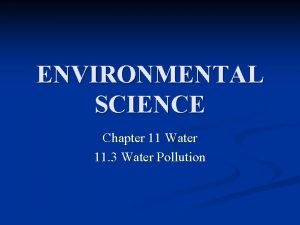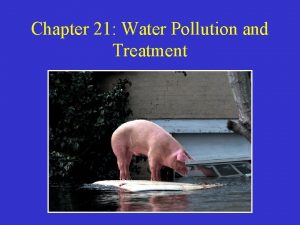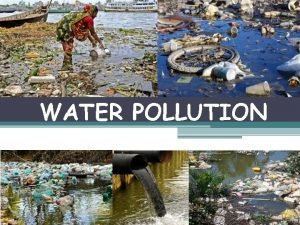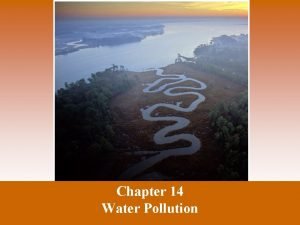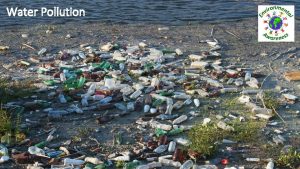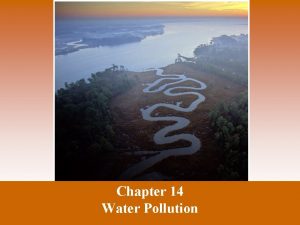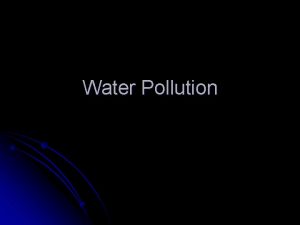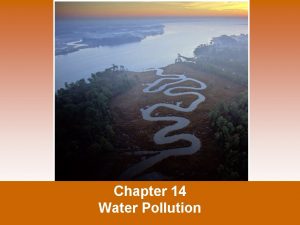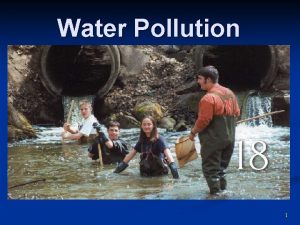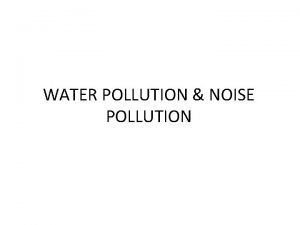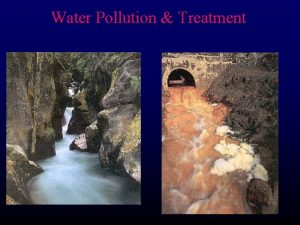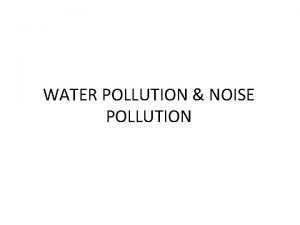Water Pollution Water Pollution Pollution is the introduction

















- Slides: 17

Water Pollution

Water Pollution • Pollution is the introduction of harmful substances into the environment. Water can become so polluted that it can no longer be used or can even be deadly.

Point Source Pollution • A specific source of pollution that can be identified.

Point Source • Factories releasing chemical waste directly into rivers • Heat pollution factories releasing heated water back into lake or rivers • Trash dumping directly into a water source.

Point-Source Pollution, continued • Oil Spills If not handled properly, oil transports can cause oil spills.

Nonpoint-Source Pollution • A widely spead source of pollution that can't be tied to a specific point of origin • Most ocean pollution is nonpoint-source pollution and can be difficult to regulate and control.

Nonpoint Source Pollution • Runoff – Urban – Agricultural • Sewage – Urban untreated – Agricultural from septic tanks or farm waste • Smoke and exhaust – Cars and factories • Leaking containers – Stored containers under ground

Monitoring Water Quality • A number of government programs monitor surface water and groundwater quality in North Carolina. • Water-quality monitoring programs look for chemical and biological imbalances in a body of water. Detecting these imbalances can help scientists correct problems in the water supply.

EPA • Environmental Protection Agency • Responsible for developing water-quality standards. • Responsible for monitoring and enforcing laws created by congress.

The Federal Water Pollution Control Act of 1948 • Created a comprehensive set of water quality programs that also provided some financing for state and local governments. • Enforcement was limited to interstate waters. • The Public Health Service provided financial and technical assistance

The Water Quality Act of 1965 • Required states to issue water quality standards for interstate waters. • Authorized the newly created Federal Water Pollution Control Administration to set standards where states failed to do so.

The Clean Water Act (CWA)1972 • Is the primary federal law in the United States governing water pollution • Passed in 1972, • The act established the goals of eliminating releases of high amounts of toxic substances into water • Eliminating additional water pollution by 1985 • Ensuring that surface waters would meet standards necessary for human sports and recreation by 1983.

The Clean Water Act (CWA)1972 • The principal body of law in effect is based on the Federal Water Pollution Control Amendments of 1972. • Was significantly expanded from the Federal Water Pollution Control Amendments of 1948. • Major amendments were enacted in the Clean Water Act of 1977 and the Water Quality Act of 1987.

Safe Drinking Water Act (SDWA)1974 • Is the principal federal law in the United States intended to ensure safe drinking water for the public. • Pursuant to the act, the Environmental Protection Agency (EPA) is required to set standards for drinking water quality and oversee all states, localities, and water suppliers who implement these standards.

Where Water Comes From • More than half of the people living in North Carolina depend on groundwater for their water supply. • Groundwater in North Carolina is stored in aquifers that are located in the subsurface throughout the state.

Where the Water Goes • Water in Agriculture Most of the water that is lost during farming is lost through evaporation and runoff. • Water in Industry About 19% of water used in the world is used for industrial purposes, such as manufacturing goods.

Where the Water Goes, continued • Conserving Water at Home You can help conserve water by taking shorter showers and by turning the water off while brushing your teeth. • This graph shows how water is used in the home.
 Water and water and water water
Water and water and water water Ap environmental science chapter 11
Ap environmental science chapter 11 Introduction of water pollution
Introduction of water pollution Introduction about water pollution
Introduction about water pollution Industrial waste causes
Industrial waste causes Hát kết hợp bộ gõ cơ thể
Hát kết hợp bộ gõ cơ thể Slidetodoc
Slidetodoc Bổ thể
Bổ thể Tỉ lệ cơ thể trẻ em
Tỉ lệ cơ thể trẻ em Gấu đi như thế nào
Gấu đi như thế nào Tư thế worm breton
Tư thế worm breton Alleluia hat len nguoi oi
Alleluia hat len nguoi oi Môn thể thao bắt đầu bằng từ chạy
Môn thể thao bắt đầu bằng từ chạy Thế nào là hệ số cao nhất
Thế nào là hệ số cao nhất Các châu lục và đại dương trên thế giới
Các châu lục và đại dương trên thế giới Cong thức tính động năng
Cong thức tính động năng Trời xanh đây là của chúng ta thể thơ
Trời xanh đây là của chúng ta thể thơ Cách giải mật thư tọa độ
Cách giải mật thư tọa độ

